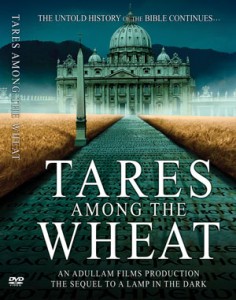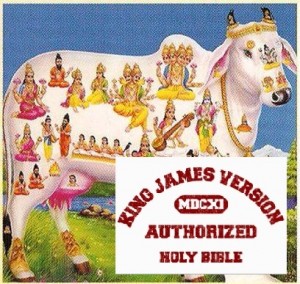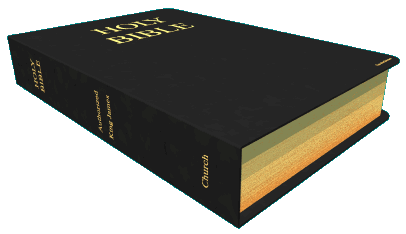By Cris Putnam
 In reply to Chris Pinto: http://www.noiseofthunder.com/articles/2013/9/12/the-cris-putnam-review.html
In reply to Chris Pinto: http://www.noiseofthunder.com/articles/2013/9/12/the-cris-putnam-review.html
I would like to thank Chris Pinto for his civility in engaging my questions and concerns. My difficulty with the alleged conspiracy is the lack of a discernible pay off for the conspirator. Pinto clarified that the purpose of the conspiracy was simply to undermine Sola Scriptura, the reformation doctrine that “scripture alone” as the standard for Christian faith and practice by way of calling biblical inerrancy into question and, as a result, to promote the ecumenical movement toward a one world religion. First he clarified that the film is centered on German scholar, Constantine von Tischendorf and his discovery of Codex Sinaiticus and then he connects this to Rome’s agenda to undermine inerrancy. Pinto writes:
Second, the purpose of Rome (as we understand it) was not to promote Catholic theology, but rather to destabilize the foundation of the Biblical record by shattering the concept of Biblical inerrancy. Her reason for doing this was to open the door to ecumenical compromise and the promotion of a one world religious movement. This is why the film ends showing the Parliament of World Religions in 1893. This was the beginning of the modern day ecumenical movement, the promotion of the idea that there are many paths to finding God, and that Christianity should be seen as just one religion among many.
I do not understand how a manuscript copy can possibly shatter the concept of biblical inerrancy. Accordingly, I am concerned that Pinto’s definition of inerrancy is too fragile. Protestant theologians widely agree that inerrancy applies exclusively to the original autographs by the first century writers like Paul and John. The Chicago Statement on Biblical Inerrancy was formulated in October 1978 by more than two hundred evangelical leaders at a conference sponsored by the International Council on Biblical Inerrancy (ICBI), held in Chicago. Article X states:
We affirm that inspiration, strictly speaking, applies only to the autographic text of Scripture, which in the providence of God can be ascertained from available manuscripts with great accuracy. We further affirm that copies and translations of Scripture are the Word of God to the extent that they faithfully represent the original.
We deny that any essential element of the Christian faith is affected by the absence of the autographs. We further deny that this absence renders the assertion of Biblical inerrancy invalid or irrelevant.[1]
Thus, a later copy like Codex Sinaiticus could not really affect the doctrine of inerrancy as it reflects mistakes by later copyists rather than the original inspired authors. In the nineteenth century when Tares claims this conspiracy was being perpetrated there is evidence to the contrary.
In his encyclical Providentissimus Deus (On the Study of Holy Scripture), Pope Leo XIII emphasized that the Bible in all its parts was inspired:
Because the Holy Ghost employed men as His instruments, we cannot therefore say that it was these inspired instruments who, perchance, have fallen into error, and not the primary author. For, by supernatural power, He so moved and impelled them to write-He was so present to them-that the things which He ordered, and those only, they, first, rightly understood, then willed faithfully to write down, and finally expressed in apt words and with infallible truth. [2]
Why would the Pope write this if there was a long term plan to undermine the Bible? This encyclical, dated November 18, 1893, was written to specifically refute what Pinto claims Rome was promoting. Seeing the threat of Darwinism, Pope Leo XIII wrote that true science cannot contradict scripture when it is properly explained and that what seems to be proved by science can turn out to be wrong. The idea that Rome had an organized agenda to discredit the Bible and promote Darwinism at this point in history is not supported by the evidence albeit that developed later in twentieth century as documented in Exo-Vaticana. Of course Rome has now fully embraced the Darwinian ideas that Leo XIII was standing against, an inconsistency that counts against the notion of an infallible papacy and teaching magisterium.
On the Text-type Argument
It seems inconsistent for him to quote scholars like Bruce Metzger to dispute the text type argument because textual scholars agree that Codex Sinaiticus is authentic. The only experts in Tares are KJVonlyists. So if he is willing to use the authority of Metzger to dispute the existence of text types, why not accept it for Sinaiticus? Metzger wrote that Sinaitics is an ancient, handwritten unical copy of the Greek Bible.[2a] Furthermore, Metzger expressed technical arguments over text types, which he thought to be an oversimplification, it doesn’t dismiss my previous point. Sinaiticus matches so many known ancient sources it renders the forgery claim implausible. Even so, it is widely accepted in general terms that there are three basic manuscript families. I am concerned that neither of us is qualified to accurately discuss the issues involved in textual criticism. Here is in excerpt from Dr. David Allen Black and Thomas D. Lea’s seminary level textbook The New Testament: it’s background and Message:
The Practice of Textual Criticism
Textual scholars have developed rules for carrying out their studies to arrive at the best reading. Of course, these principles cannot be applied unthinkingly, nor do all apply in each instance of textual variation. These principles are based either upon the external evidence or the internal evidence.
External evidence seeks to determine which reading is supported by the most reliable witnesses (i.e., the Greek manuscripts, versions, and Church Fathers). These witnesses have been divided into three basic families or “texttypes”: the Alexandrian, the Western, and the Byzantine. Most modern scholars believe the Alexandrian text most closely approximates the original text of the New Testament. Other scholars prefer the Byzantine text.
The basic principles of external evidence include the following: (1) prefer the reading attested by the oldest manuscripts; (2) prefer the reading that is the most widespread geographically; and (3) prefer the reading supported by the most number of texttypes.
The basic principle of internal evidence is that the reading from which the other readings could most easily have arisen is probably original. This principle has several corollaries: (1) prefer the shorter reading; (2) prefer the more difficult reading; (3) prefer the reading that best fits the author’s style and diction; and (4) prefer the reading that best fits the context.
As we have said, the application of these principles is not a merely mechanical process. Skill and judgment are demanded in assessing the evidence and in determining the most probable reading.
We can be grateful that the materials for the practice of New Testament textual criticism are quite numerous. By contrast, the materials for determining the text of the writings of Plato or the Roman poet Virgil are few in number and are separated from the originals by as much as fourteen hundred years. New Testament textual criticism has assisted us by providing access to substantially the same text which the first-century writers produced.[3]
The goal of text criticism is to get back to the original autographs and because archeologists have discovered thousands more ancient sources since the reformation period, today’s scholars are in a much better position to make these determinations than a Roman Catholic monk like Erasmus working with only six late copies and the Latin Vulgate. I want to put the best defense forward in arguing for the veracity of scripture and modern conservative scholarship is our strongest ally. Pinto’s movie calls it all into question.
Playing Into the Hands of Bible Skeptics
As someone with training in apologetics, I have familiarized myself with the basics in order to address the claims popularized by Dr. Bart Ehrman, author of books like: Jesus, Interrupted: Revealing the Hidden Contradictions in the Bible (And Why We Don’t Know About Them); Misquoting Jesus: The Story Behind Who Changed the Bible and Why; Forged: Writing in the Name of God–Why the Bible’s Authors Are Not Who We Think They Are. As one can readily see from the titles, Ehrman has made a career out of attacking the veracity of scripture. Scholars like David Allen Black and Daniel Wallace are evangelical champions of Biblical inerrancy and are uniquely qualified to address the likes of Ehrman. I highly recommend the following video:
Unfortunately, it seems that often skeptics have a better grasp on text-critical issues than the average believer. Often Ehrman’s arguments are used to destroy the uninformed believer’s faith. I am concerned that Pinto’s film Tares Amongst the Wheat plays right into the hands of these skeptics by promoting widely discredited scholarship from Textus Receptus advocates. Without going into specifics here, a modicum of open-minded research should dispel the notion that Textus Receptus is superior.[4] Textus Receptus was compiled by Erasmus, a Roman Catholic scholar, using only six very late manuscripts and even back translation from the Latin Vulgate when he was missing a Greek source.[5] Doesn’t it seem inconsistent that Protestant scholars like Daniel Wallace and James White are disputed in order to exalt the work of the Catholic monk Erasmus?
Putnam asked: Where’s the payoff for Rome?
The answer to his question is the ecumenical movement. The answer could be seen in the ecumenical activities of Billy Graham in the 20th century, joining with Catholic priests and nuns in his crusades, or in the 1994 document Evangelicals and Catholics Together. With this, it could also be seen in Assisi, Italy in 1986 when Pope John Paul II met with religious leaders from all over the world, with Buddhists, Muslims, Hindus, American Indian Shamans, etc. As he joined hands with them in prayer he told them, “We are all praying to the same God.” An inerrant Bible that is taken too literally would be destructive of unity between the various “Christian” groups, and the differing religions of the world. Destroying the concept of Biblical inerrancy opens the door to compromise and apostasy through ecumenism
Pinto argues that modern biblical scholarship undermined inerrancy and this led to the ecumenical movement. However, he failed to show any evidence for this connection. It seems to me that the rise of Darwinian evolution did the damage rather than biblical scholarship. It also seems like the Roman Catholic Church is in decline. If they are really going to lead a global religion then a non-linear event of transcendent proportion will need to occur (this is the reasoning behind Exo-Vaticana). Although I do not agree with Evangelicals and Catholics Together (along with John MacArthur and R.C. Sproul who I quoted in Petrus Romanus ), correlation does not equate to causation. Even so, most of those who did sign it like Billy Graham and Charles Colson also affirm biblical inerrancy. So the argument is a non sequitur—it just doesn’t follow. My original criticism stands, Tares Amongst the Wheat is a conspiracy theory without an actual conspiracy and, unfortunately, I am more concerned that it undermines conservative evangelical biblical scholarship which is our best line of defense in an increasingly anti-Christian culture.
[1] The Chicago Statement on Biblical Inerrancy: http://www.spurgeon.org/~phil/creeds/chicago.htm (accessed September 18, 2013).
[2] Pope Leo XIII “On the Study of Holy Scripture”, http://www.vatican.va/holy_father/leo_xiii/encyclicals/documents/hf_l-xiii_enc_18111893_providentissimus-deus_en.html (accessed September 18, 2013).
[2a] Bruce Metzger & Bart D. Ehrman The Text of the New Testament: An Introduction to the Critical Editions and to the Theory and Practice of Modern Textual Criticism, (New York – Oxford: Oxford University Press, 2005) 62.
[3]Thomas D. Lea and David Alan Black, The New Testament: Its Background and Message, 2nd ed. (Nashville, TN: Broadman & Holman Publishers, 2003), 77–78.
[4] Douglas S. Chinn and Robert C. Newman, “Demystifying the Controversy Over the Textus Receptus and The King James Version of the Bible” KJVOnly.org, http://www.kjvonly.org/other/demystify.htm (accessed September 18, 2013).
[5] Metzger, The Text of the New Testament, pp. 99–100; Kurt Aland – Barbara Aland, The Text of the New Testament. An Introduction to the Critical Editions and to the Theory and Practice of Modern Textual Criticism,Translated by Erroll F. Rhodes. Grand Rapids: Eerdmans, 1989, 4.





